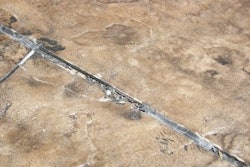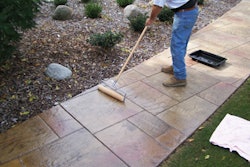
State Highway 34 in South Dakota runs across the state connecting Wyoming's Highway 24 on the west to the Minnesota border on the east. Local traffic dominates the highway that connects many small towns.
Although truck traffic usually travels on Interstate 90, parallel to Highway 34, about 15 percent of the traffic travels along the highway.
Like most roads, Highway 34 requires repairs occasionally, and during the past summer, two-lane sections near Pierre and Fort Pierre needed rehabilitation. Commercial Asphalt in Mitchell, SD, received the bid for a 13.8-mile section east of Pierre and began to mill the old highway.
Neil Waldera, a superintendent at Commercial Asphalt, helped manage the project and said his crew milled 1.5 inches of the old asphalt's top layer. The new Class Q2 asphalt included 20 percent of the recycled asphalt pavement (RAP) in the mix with 58/28 oil.
"That's a common mix in South Dakota," said Waldera, who manages the traveling crew and the portable asphalt plant. Morris, Inc., Fort Pierre, provided virgin aggregate to the portable plant site where it was mixed with RAP and other materials to produce new asphalt. Commercial Asphalt used its trucks to deliver the hot mix to the repair site.
Over 75 percent of the material was stockpiled at the portable plant site located eight miles away from Highway 34 where the crew was working, said Waldera. "The plant can put out about 400 tons per hour, and for this project, we produced 33,500 tons."
Commercial Asphalt also used its Caterpillar pavers and rollers to pave the new surface, which required three weeks to a month to complete, including painting stripes in the middle of the two lanes. Thirty employees helped to rebuild this asphalt highway for $2.8 million paid by the South Dakota Department of Transportation.
Soil conditionsThe highway west of Fort Pierre was rehabilitated because of various soil conditions that demanded different solutions, said Jim Hyde, area engineer for the South Dakota Department of Transportation.
Buskerud Construction, Dell Rapids, SD, reworked small sections of Highway 14 and 34 in the 25 miles west of Fort Pierre. "In a majority of the areas, the asphalt and gravel base was removed and the soil was undercut and recompacted," said Hyde.
The DOT geotechnical office designed four different solutions for the 13 sections that needed geotechnical repair to correct faults and heaves. "Some areas needed drains on both sides of the road to drain excess water away from the grade. In some areas, we mixed 12 percent fly ash with the dirt to neutralize the effects on the condition of the road.
"In other areas, we dug extra deep and backfilled with sand to minimize the impact those locations have on the driving surface," Hyde explained. "There was one area where the fault was more severe than other areas, and we undercut deeper, scarified the fault, and filled it with about two feet of sand, then put in the rest of the fill and resurfaced the area."
Two highways repavedA few heaves required several previous patches by DOT Maintenance employees to cover the significant movement that could be a foot high, said Hyde. "By removing the bumps, we could re-establish uniform surfacing under the new pavement."
Highway 34 connects to Highway 14, which also was rehabilitated. Work on the two highways began in May. During the summer, engineers found the faults and designed methods to correct the problems. The highway west of Fort Pierre was last repaved in 1996 when contractors milled the asphalt and mixed it with gravel prior to paving a new asphalt surface. From 1996 to the present, the DOT worked on patching and grinding to repair some of the problems. Highway 34 east of Pierre was last resurfaced in 1987.
"Our basic philosophy is that if we milled and overlaid what was on the surface, faults and heaves would reflect through the new surface, and motorists wouldn't have a pleasing ride. By repairing the road as we have done, these conditions may not occur again. If the conditions come back, they will be less severe than before we patched them," said Hyde.
The underlying soil conditions shortened the life of Highway 34, according to Hyde. "Normally we'd get more life than 13 years from these pavements. We've done a lot of work on Highway 34 in the last couple of years. If anyone travels from Wyoming to Minnesota through South Dakota, they will notice a big improvement in the last couple of years."


















